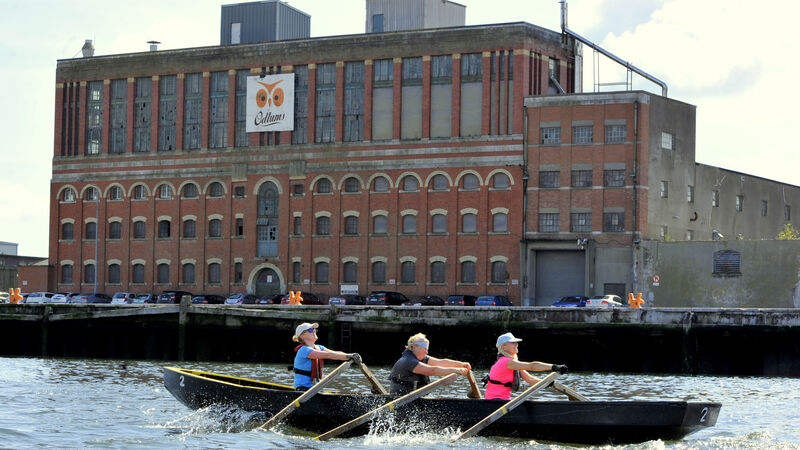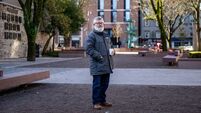Michael Moynihan: Odlums and hypercapitalism — lessons from New York City

The old Odlums building in Cork City: More often than not, one or two people will stop and look up from the coffee or the burrito, and you can almost read their thoughts. Wouldn’t this make a sensational apartment building? Wouldn’t this be the coolest address in Cork? Picture: Gavin Browne
The old Odlums building on Kennedy Quay has a particular name in our house.
My research assistants are inclined to call it “the Matrix house”, based on the five minutes they’ve seen of the Keanu Reeves film.
The rain streaming down those buttresses, the post-industrial landscape, the eerily wide space stretching out front to the river: they might have a point.
The building is impressive even as a disused shell, dwarfing the people drifting up from the Marina Market further down the quay. More often than not, one or two of them will stop and look up from the coffee or the burrito, and you can almost read their thoughts.
Wouldn’t this make a sensational apartment building? Wouldn’t this be the coolest address in Cork?
“Driver, One Odlum Towers, and step on it.”
In one way, it’s almost disappointing that it hasn’t been colonised already. It looks turnkey-ready for a nest of artists, with ideas and creativity and debate and direction flowing out of it. If you close your eyes — mind that coffee and burrito — you can almost imagine the creative types practically spilling out through those long, narrow windows.
But only in one way, as I said.
Let me explain. At present, your columnist is working his way through , an absolutely terrific book by Tom Dyja about New York’s ups and downs over the last 40 years.
I hesitate to give a precise order for that rise and fall, or fall and rise, because there are so many moving parts involved — international money and local tax schemes, disco and hip-hop, rocketing crime statistics that then plummet, various fiefdoms in elbows-out political combat, reputations ebbing and flowing with the decades. It’s difficult to put your finger on a year, month, or even a particular week when something seismic isn’t happening.
What’s noticeable, though, is the recognisable cycle in at least one significant area of the city’s life — the rolling gentrification of once-neglected areas, which then become havens for the super-rich.
If this phenomenon didn’t actually spring to life in New York, it’s closely identified with the city through the restoration of parts of Brooklyn, for instance.
This was no small matter. In the late '80s, your columnist visited a couple of Brooklyn neighbourhoods briefly and, with all due respect, at least once, I swallowed hard about my prospects of getting out in one piece after the sun went down.
All change now. A couple of years ago, I visited again in the company of the great John Riordan, once of this parish. He issued a warning on the subway journey, though.
“Don’t be that guy.”
“What guy?” I asked.
“You know, mocking the place. Brooklyn, hipsters, painfully cool. It’s not like that at all.”
We came up out of the subway station on Flatbush Ave to be greeted by a man offering to write poetry to order. For cash. On a manual typewriter. Which was perched on a little desk in front of him.
(“I see this all the time on Patrick St,” I said to Riordan afterwards.)
Even then, though, Brooklyn rents were skyrocketing, and John was pointing out premises which once housed small shops but which were now occupied by bank branches, the only organisations which could absorb the increased rents.
The point here is that for a brief period of time the two co-exist: the hipster poet with his consciously analogue props is there, but the faceless, frictionless arrival of serious money is also occurring. This imbalance never lasts for long, and those who have made the area attractive in the first place pack up and move on.
That’s why the cynic in me, never silent for very long, wonders if we’ve been proactive in Cork by sidestepping this inevitable phase down on Kennedy Quay.
There isn’t a seamless match when it comes to the circumstances in Cork and super-cities such as New York. That goes without saying. But lessons learned in the hyper-accelerated urban laboratory across the water can be absorbed here.
Take the unintended consequences of integrating old infrastructure and new developments. One of the great achievements of modern New York, as Tom Dyja teases out, is the High Line, a public park created by repurposing an abandoned stretch of elevated rail line.
Once a derelict steel hulk, now it’s a soothing park and walking area in the heart of the city: readers who’ve been to the city will probably recall a high greenway they walked on, or at least saw in the distance.
But part of the original deal in refurbishing that rail line was an interesting agreement with those who owned the land alongside it. In exchange for relinquishing their ‘air rights’ near the High Line, those landowners “could build bigger, higher buildings”, writes Dyja, “most likely luxury apartments”.
(He also points out that when leaving office as mayor, Rudy Giuliani signed a demolition order for the original rail line, but that’s for another day.)
If we’ve moved past the chances of the Odlums building becoming an artists' colony, is this the next incarnation for it? As an adrenalising agent for construction prices, a steroidal booster when it comes to the closest apartment block?
A reader asked me recently why I was so interested in the Docklands, and whether it had anything to do with the good coffee now widely available there.
Shrugging off the calumny, I pointed out that there was an opportunity to achieve something memorable in the area as it’s being redeveloped.
I added that I couldn’t remember the last time such a large swathe of the city was due for such a sweeping change, and we all had a civic obligation to pitch in and contribute to the best possible outcome, in whatever form that contribution could take.
Hence, I said, sweeping to a memorable conclusion, the centrality of somewhere such as Odlums to my vision, or your vision, of what should be done with the area.
This was just one interesting sideshow in Dyja’s book, by the way. There are dozens, including the ongoing importance of public parks in the renaissance of New York, and how the viability of those parks as assets to the public is a key indicator of the city’s health as a whole (which I may come back to at a later stage.)
One throwaway line summed up the gentrification cycle better than anything else.
At the end of his book, Dyja lists the changes in New York: the fact that Ernst and Young’s headquarters now occupies the space where Keith Haring and Jean-Michel Basquiat first hung their paintings jumps out.
Keep that in mind when you’re daydreaming about what to do with Odlums.












